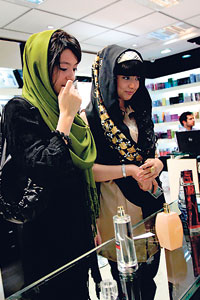TEHRAN (AFP) - Banned after the 1979 Islamic revolution, cosmetics like lipstick and nail polish have flooded Iran so much in recent years that it is now the Middle East's second largest beauty products market.
Following the revolution, the morality police patrolled the streets, fining or even arresting women who flaunted the strict rules until they were eased after the 1980-1988 Iran-Iraq war.
 |
| Iranian women test fragrances of perfumes at a cosmetics shop in Tehran. |
And most women were quick to catch on after a decision to allow imports in the mid-1990s with many taking to the streets all dolled-up, especially chic young urbanites.
Iranians spend about two billion dollars a year on cosmetics and the country of 74 million accounts for 29 percent of the Middle East market, which is dominated by Saudi Arabia, according to a recent survey.
Most beauty products are now imported or smuggled into Iran, as the country produces little of its own makeup but has a vast, porous coastline just across the water from modern Gulf city states like Dubai.
Almost all popular international brands like Yves Saint Laurent, Guerlain, L'Oreal and Bourjois are available at trendy uptown malls and stores in cities and large towns.
"Most specialists estimate that about 700 to 750 million dollars worth of products are imported to Iran illegally," said Abbas Najafi, the head of Iran's counter-trafficking bureau.
According to a survey conducted by TMBA, a private economic research institute, about 14 million urban Iranian women aged between 15 and 45 spend seven dollars on average per month on cosmetics.
With the minimum wage in Iran set at 300 dollars and the average monthly income between 600 and 700 dollars, that is a fair amount.
TMBA said Iranians splurge on cosmetics probably because most of the population is young and urban: half the population is below 30 years old, and 65 percent is urban.
Since 1979, women have had to observe the Islamic dress code, mandating that hair and body be modestly covered in public.
To abide by the code, outside the home most urban women wear a headscarf, and a loose coat over their regular clothes.
Women have also constantly challenged the dress code by sporting shorter, tighter Islamic overcoats and flashing locks of dyed hair under loosely-worn scarves, drawing condemnation and occasional crackdowns by the hardliners in power.
Women in government jobs still cannot wear makeup at work. "Because of the veil (dress code), young Iranians pay a lot of attention to their faces," which together with hands are the only body parts visible in public, said Mina, who sells cosmetics in the Iranian capital. |


